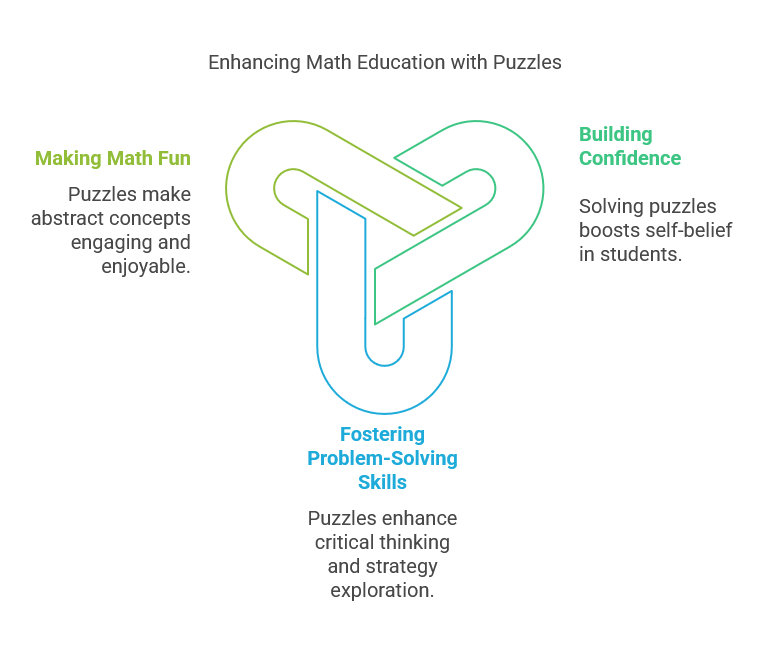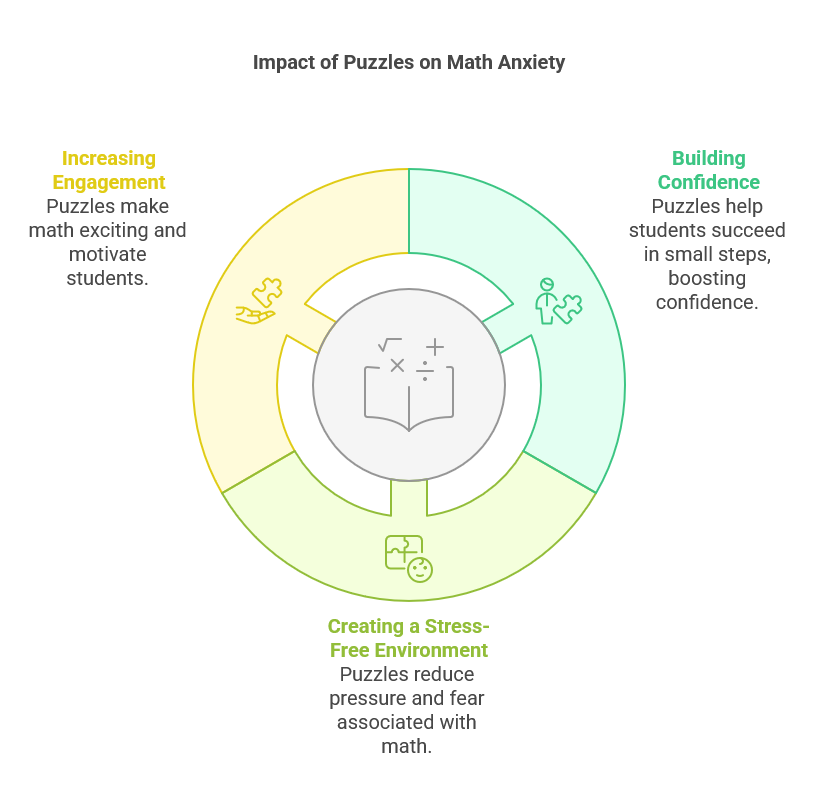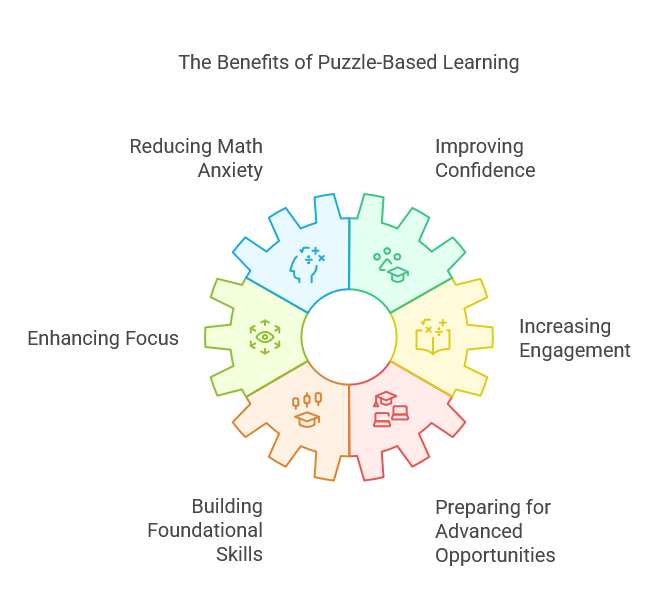Introduction
Why does math often evoke fear rather than fascination? Across classrooms worldwide, math anxiety—a crippling fear of math—affects millions. In the UK, a staggering one-third of adults report feeling stressed or worried when faced with mathematical tasks. This anxiety not only impacts academic success but also limits career opportunities, particularly in STEM fields.
But what if math could feel less like a chore and more like a game? Puzzles offer a way to turn fear into fun, helping students build both confidence and competence in math. By combining engagement with problem-solving, puzzles create a pathway to break the cycle of math anxiety.
What Is Math Anxiety?
Math anxiety is more than a dislike for numbers; it’s a psychological barrier that can lead to avoidance, reduced confidence, and long-term disengagement. Research reveals that math anxiety often begins early, stemming from negative experiences in the classroom. Left unaddressed, this anxiety can snowball, discouraging students from pursuing math-related opportunities later in life.
The effects of math anxiety extend beyond academics. It shapes career trajectories, pushing students away from lucrative fields like engineering, data science, and technology. Overcoming this challenge requires innovative solutions—and that’s where puzzles come in.
How Puzzles Transform Math Education
Puzzles are more than games; they are tools for cognitive growth and problem-solving. By engaging the brain in creative and analytical thinking, puzzles help students explore mathematical concepts without fear of failure.
Why Puzzles Work
- They Build Confidence: Solving a puzzle creates a sense of accomplishment. Each success reinforces a student’s belief in their abilities.
- They Foster Problem-Solving Skills: Puzzles challenge students to think critically, recognize patterns, and explore multiple strategies.
- They Make Math Fun: By turning abstract math concepts into hands-on challenges, puzzles remove intimidation and spark curiosity.

Types of Puzzles for Math Education
- Logic Puzzles: Examples like Sudoku or logic grids teach reasoning and structured thinking.
- Number Riddles: These brain teasers help students practice arithmetic in a playful way.
- Pattern Puzzles: Tasks that involve identifying and continuing patterns build critical thinking skills essential for algebra and geometry.
Imagine a student struggling with fractions. Instead of worksheets, they solve a “pizza puzzle,” dividing slices among friends. This tangible approach makes math concepts relatable and memorable.
How Puzzles Help With Breaking the Math Anxiety Cycle
Building Confidence
Puzzles allow students to experience success in small, manageable steps. For example, completing a simple Sudoku puzzle can reinforce their ability to analyze and solve problems. This incremental growth builds confidence, helping students tackle more complex math challenges.
Creating a Stress-Free Environment
Unlike traditional tests, puzzles are low-pressure. They encourage trial and error, showing students that mistakes are part of learning. This safe space reduces fear and fosters a positive attitude toward math.
Increasing Engagement
For students who find math boring or overwhelming, puzzles offer a fresh perspective. Gamified learning taps into intrinsic motivation, transforming math from a dreaded subject into an exciting challenge. Over time, this engagement can shift how students perceive their capabilities.

Bringing Puzzles Into Math Education
Strategies for Teachers
Teachers can integrate puzzles into their classrooms with ease:
- Start with Warm-Ups: Use quick puzzles to kick off lessons and grab attention.
- Group Activities: Promote teamwork through collaborative puzzle-solving.
- Assessment Alternatives: Replace traditional quizzes with puzzles to assess problem-solving skills.
For instance, during a geometry lesson, students could solve pattern puzzles to explore symmetry and shapes interactively.
Role of Parents in Breaking the Math Anxiety Cycle
Parents are key allies in reducing math anxiety. They can:
- Incorporate Math Puzzles at Home: Everyday activities like cooking or budgeting can become playful math exercises.
- Encourage Collaboration: Solving puzzles as a family builds teamwork and reduces stress.
Imagine a parent turning grocery shopping into a math game, asking their child to calculate the best value for items. This simple activity makes math practical and fun.
Resources for Self-Learners
For independent learners, online resources provide endless opportunities to explore math through puzzles. Platforms like Math Pickle and Breakout EDU offer puzzles tailored to different skill levels, enabling learners to progress at their own pace.
The Science Behind Puzzle-Based Learning
Research Findings
Studies consistently highlight the effectiveness of puzzles in reducing math anxiety. For example, research shows that students who regularly engage with puzzles experience improved confidence, better focus, and higher engagement with math tasks.
Long-Term Impact
Early exposure to puzzles builds foundational skills that last a lifetime. By developing critical thinking and problem-solving abilities, students are better prepared for advanced math and STEM opportunities.

Real-World Success Stories
Consider a middle school classroom where math anxiety was the norm. Teachers introduced puzzles like “Area Maze” and “Fireworks” into the curriculum. At first, students were hesitant, but as they engaged with these challenges, their confidence grew. By the end of the term, not only had their math skills improved, but they also reported enjoying math—a subject they once feared.
Why You Should Act Now
Math anxiety is a barrier, but it doesn’t have to be a permanent one. Puzzles offer a proven way to create a fun, supportive, and effective math learning experience. By fostering confidence, reducing stress, and encouraging engagement, puzzles can transform how students approach math.
Call to Action
Educators and parents, it’s time to take the first step in breaking the math anxiety cycle. Explore free resources like Math Pickle or Breakout EDU, or try creating your own puzzles tailored to your students’ or children’s needs. Together, we can turn math into an adventure, one puzzle at a time.
Conclusion
Breaking free from math anxiety starts with changing the way students interact with numbers. By incorporating puzzles into education, we can foster a generation that sees math not as a source of stress but as a gateway to creativity, logic, and discovery. Let’s make math fun, engaging, and anxiety-free—for every student, everywhere.
References
- Breakout EDU. (n.d.). Math Made Fun: Breaking Free From Math Anxiety.
- Furner, J. M. (2021). An Alternative Sudoku Puzzle with Letters While Addressing Math Anxiety. Transformations, 7(1), 29-42.
- University of South Australia. (2020). Divide and conquer: A new formula to minimize mathematics anxiety.
- Education Week. (2020). The Myth Fueling Math Anxiety.
- National University. (n.d.). Decoding Math Anxiety: Building Your Confidence.
- Maths Anxiety Trust. (n.d.). A Guide for Teachers with Maths Anxiety.
- Baas, B. (2020). The Perceptions and Experiences of Math Anxiety. Dominican University of California.
- Scholaris. (n.d.). Reducing math anxiety through play-based learning approaches.
- SIP Abacus. (n.d.). Using Math Puzzles to Overcome Math Anxiety in Children.
- OSF. (n.d.). Do Games Reduce Math Anxiety? A meta-analysis.
- Sage Journals. (2015). Math Anxiety: A Factor in Math Achievement Not to Be Ignored.
- Mountain Scholar. (n.d.). The Relationship Between Math Anxiety and Math Achievement.
- ResearchGate. (2023). Game-Based Learning and Math Anxiety.
- ResearchGate. (2019). Mathematics Anxiety: Definition, Prevention, Reversal Strategies and School Setting Inclusion.
